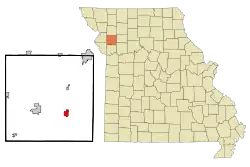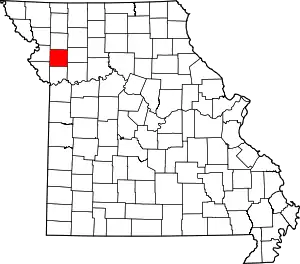Lathrop, Missouri
Lathrop is a city in Clinton County, Missouri, and is part of the Kansas City metropolitan area within the United States. The population was 2,086 at the 2010 census.
Lathrop, Missouri | |
|---|---|
| Nickname(s): The Mule Capital of the World | |
 Location of Lathrop, Missouri | |
| Coordinates: 39°32′57″N 94°19′47″W | |
| Country | United States |
| State | Missouri |
| County | Clinton |
| Area | |
| • Total | 1.83 sq mi (4.75 km2) |
| • Land | 1.83 sq mi (4.75 km2) |
| • Water | 0.00 sq mi (0.00 km2) |
| Elevation | 1,063 ft (324 m) |
| Population | |
| • Total | 2,086 |
| • Estimate (2019)[3] | 2,010 |
| • Density | 1,096.56/sq mi (423.34/km2) |
| Time zone | UTC-6 (Central (CST)) |
| • Summer (DST) | UTC-5 (CDT) |
| ZIP code | 64465 |
| Area code(s) | 816 |
| FIPS code | 29-40826[4] |
| GNIS feature ID | 0720826[5] |
| Website | http://www.cityoflathropmo.com |
History
Lathrop was platted in 1867 as a stop on the Cameron Cutoff Branch of the Hannibal and St. Joseph Railroad. It was named for John L. Lathrop, treasurer for the railorad.[6]>[7] A post office called Lathrop has been in operation since 1868.[8]
In the early 1900s it was considered the "Mule Capital of the World" after the firm of Guyton and Harrington sold 180,000 mules and 170,000 horses to the British Army during World War I. The cousins J.D. Guyton and W.R. Harrington owned 4,700 acres near Lathrop. They also supplied mules to the British during the Boer War.[9][10] Among the facilities in Lathrop were three barns stabling 1,000 mules each and a 496 foot long hay barn.[11] The British had a formal contract for a remount station in Lathrop. The business had facilities at 17th and Wyandotte in Kansas City and had a shipping port facilities at Chalmette, Louisiana.[11] The mule business collapsed in the 1920s. There are several businesses in Lathrop that include "mule" in their name now and a road east of town is called Mule Barn Road. The mascot of the high school team is the mules.
Geography
Lathrop is located at 39°32′57″N 94°19′47″W (39.549153, -94.329747).[12]
According to the United States Census Bureau, the city has a total area of 1.79 square miles (4.64 km2), all land.[13]
Demographics
| Historical population | |||
|---|---|---|---|
| Census | Pop. | %± | |
| 1870 | 523 | — | |
| 1880 | 746 | 42.6% | |
| 1890 | 1,082 | 45.0% | |
| 1900 | 1,118 | 3.3% | |
| 1910 | 1,038 | −7.2% | |
| 1920 | 1,100 | 6.0% | |
| 1930 | 940 | −14.5% | |
| 1940 | 1,049 | 11.6% | |
| 1950 | 888 | −15.3% | |
| 1960 | 1,006 | 13.3% | |
| 1970 | 1,268 | 26.0% | |
| 1980 | 1,732 | 36.6% | |
| 1990 | 1,794 | 3.6% | |
| 2000 | 2,092 | 16.6% | |
| 2010 | 2,086 | −0.3% | |
| 2019 (est.) | 2,010 | [3] | −3.6% |
| U.S. Decennial Census[14] | |||
2010 census
As of the census[2] of 2010, there were 2,086 people, 794 households, and 574 families residing in the city. The population density was 1,165.4 inhabitants per square mile (450.0/km2). There were 890 housing units at an average density of 497.2 per square mile (192.0/km2). The racial makeup of the city was 95.2% White, 1.2% African American, 1.2% Native American, 0.4% Asian, 0.3% from other races, and 1.7% from two or more races. Hispanic or Latino of any race were 1.2% of the population.
There were 794 households, of which 40.1% had children under the age of 18 living with them, 52.0% were married couples living together, 14.7% had a female householder with no husband present, 5.5% had a male householder with no wife present, and 27.7% were non-families. 23.4% of all households were made up of individuals, and 8.7% had someone living alone who was 65 years of age or older. The average household size was 2.63 and the average family size was 3.08.
The median age in the city was 34 years. 28.5% of residents were under the age of 18; 8.9% were between the ages of 18 and 24; 27.1% were from 25 to 44; 23.6% were from 45 to 64; and 11.7% were 65 years of age or older. The gender makeup of the city was 48.9% male and 51.1% female.
2000 census
As of the census[4] of 2000, there were 2,092 people, 766 households, and 557 families residing in the city. The population density was 1,508.5 people per square mile (581.1/km2). There were 827 housing units at an average density of 596.3 per square mile (229.7/km2). The racial makeup of the city was 96.27% White, 1.96% African American, 0.19% Native American, 0.05% Asian, 0.19% from other races, and 1.34% from two or more races. Hispanic or Latino of any race were 1.58% of the population.
There were 766 households, out of which 41.5% had children under the age of 18 living with them, 55.4% were married couples living together, 13.6% had a female householder with no husband present, and 27.2% were non-families. 23.5% of all households were made up of individuals, and 11.2% had someone living alone who was 65 years of age or older. The average household size was 2.66 and the average family size was 3.16.
In the city the population was spread out, with 29.6% under the age of 18, 9.4% from 18 to 24, 29.5% from 25 to 44, 19.6% from 45 to 64, and 11.8% who were 65 years of age or older. The median age was 33 years. For every 100 females, there were 90.5 males. For every 100 females age 18 and over, there were 86.1 males.
The median income for a household in the city was $39,537, and the median income for a family was $46,157. Males had a median income of $34,286 versus $21,344 for females. The per capita income for the city was $17,189. About 8.9% of families and 10.9% of the population were below the poverty line, including 14.7% of those under age 18 and 12.6% of those age 65 or over.
Lathrop High School
Lathrop High School currently has a student population of 297 students, with a student teacher ratio of 14:1.[15] Lathrop has had very successful sports teams throughout the 2017-2018 and 2018–2019 school year. Residents of Lathrop tend to hold their athletic programs in a high regard. Please see above.
See also
References+
- "2019 U.S. Gazetteer Files". United States Census Bureau. Retrieved July 26, 2020.
- "U.S. Census website". United States Census Bureau. Retrieved 2012-07-08.
- "Population and Housing Unit Estimates". United States Census Bureau. May 24, 2020. Retrieved May 27, 2020.
- "U.S. Census website". United States Census Bureau. Retrieved 2008-01-31.
- "US Board on Geographic Names". United States Geological Survey. 2007-10-25. Retrieved 2008-01-31.
- https://www.cityoflathropmo.org/lathrop-history.html</ref.
- "Clinton County Place Names, 1928–1945 (archived)". The State Historical Society of Missouri. Archived from the original on 24 June 2016. Retrieved 21 September 2016.CS1 maint: bot: original URL status unknown (link)
- "Post Offices". Jim Forte Postal History. Retrieved 21 September 2016.
- https://www.cityoflathropmo.org/lathrop-history.html
- https://missourioverthere.org/explore/articles/missouri-horses-and-mules/
- https://www.newspapers.com/image/51200849/?terms=Guyton%2Band%2BHarrington
- "US Gazetteer files: 2010, 2000, and 1990". United States Census Bureau. 2011-02-12. Retrieved 2011-04-23.
- "US Gazetteer files 2010". United States Census Bureau. Archived from the original on 2012-07-02. Retrieved 2012-07-08.
- "Census of Population and Housing". Census.gov. Retrieved June 4, 2015.
- "Lathrop High School Profile (2018-19) | Lathrop, MO". Public School Review. Retrieved 2019-03-02.
External links
| Wikimedia Commons has media related to Lathrop, Missouri. |
- Historic maps of Lathrop in the Sanborn Maps of Missouri Collection at the University of Missouri
